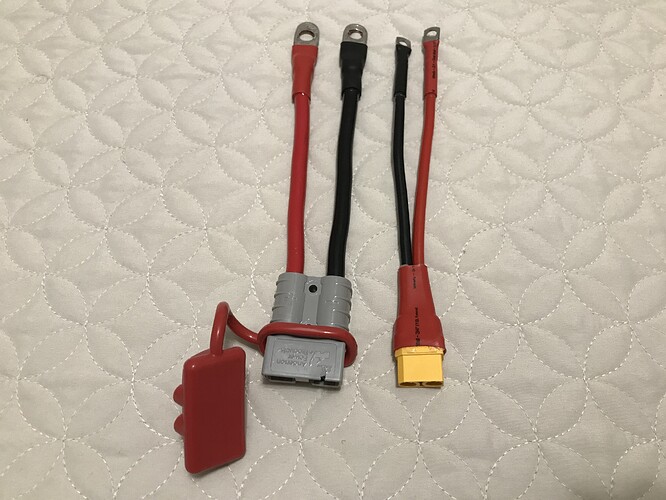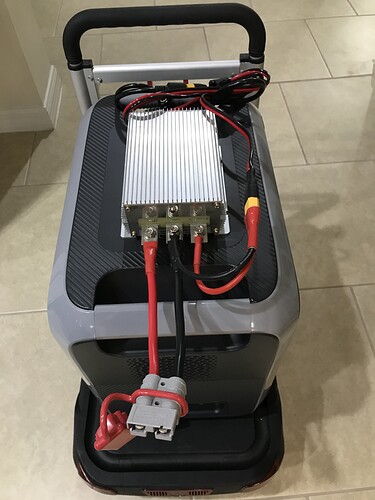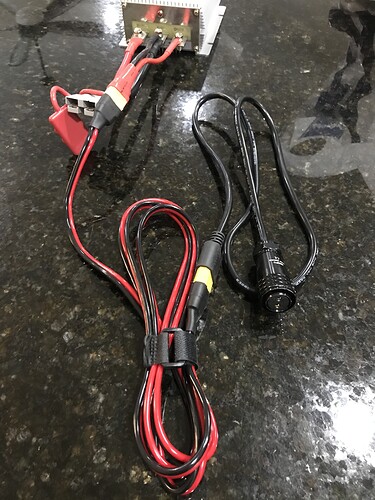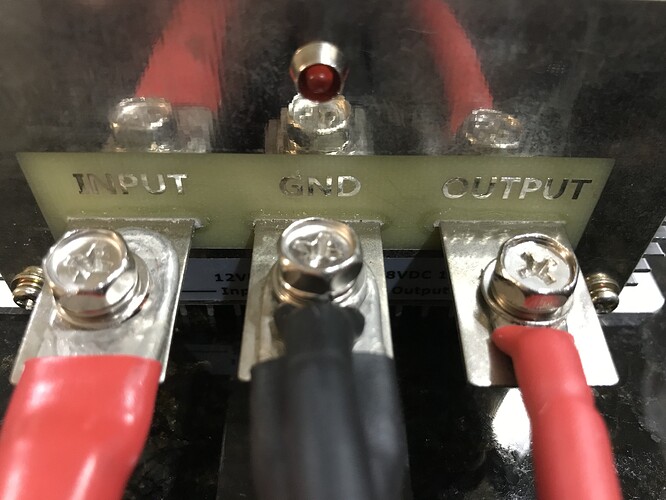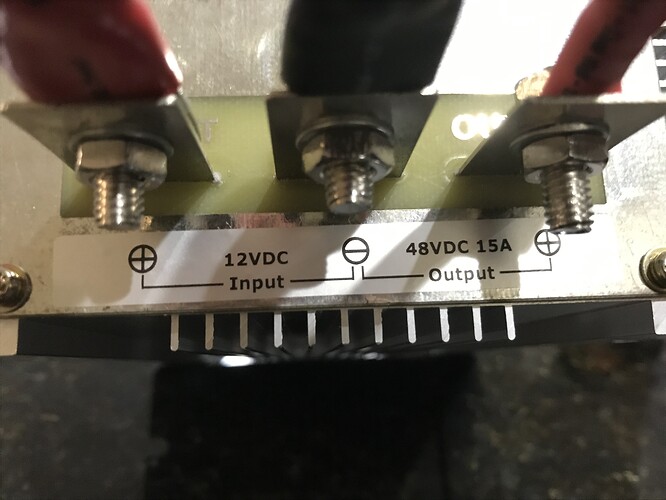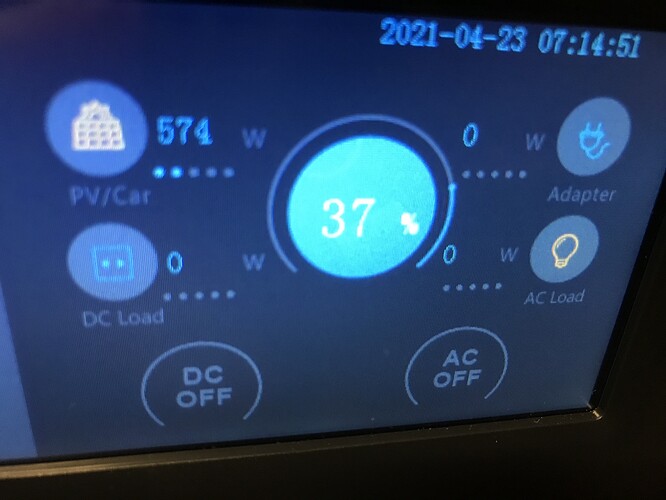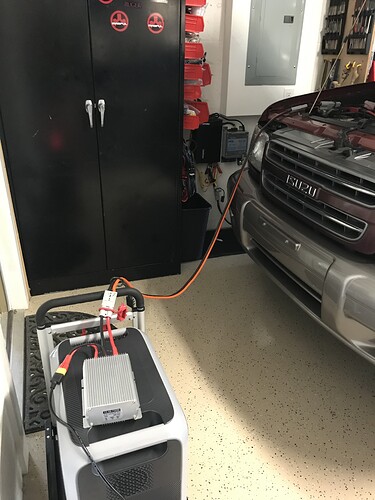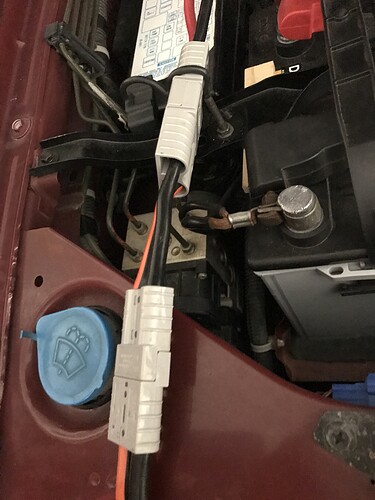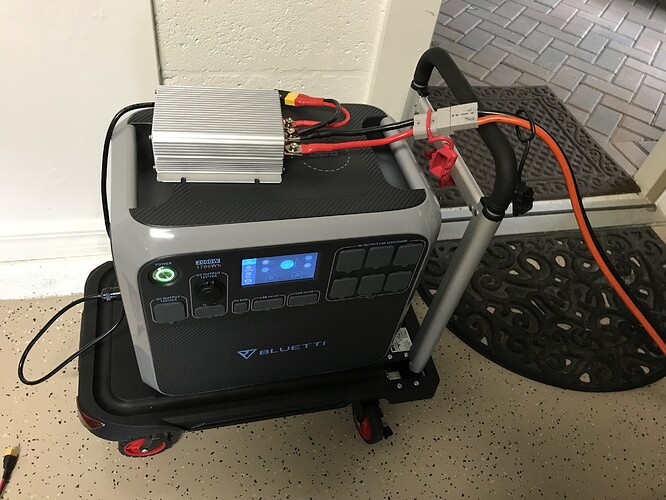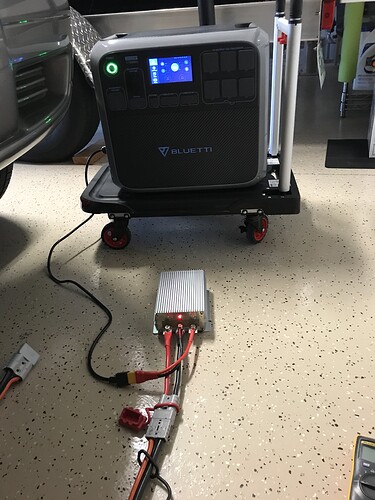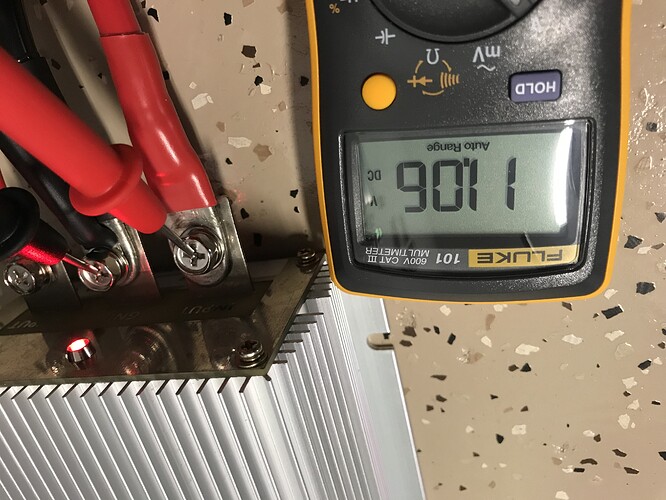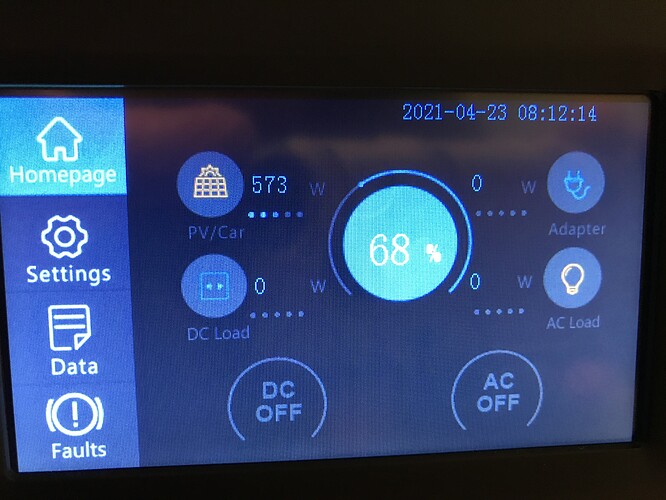One other thought you could probably take a single wire from each of the 40 amp switches and combine that so you would have enough power to use to connect to one of the transformers. That way you wouldn’t have to wire directly to the battery
Hi Scott,
Thanks for the reply.
I read your post on the fb group. Sounds very encouraging!!
So…I could get a step-up transformer that takes 12V up to 48V to use on the PV input. Would the setting need to be PV or CAR?
Would this work for me? https://www.amazon.com/uxcell-Big-Size-Waterproof-Converter-Regulator/dp/B01LYVSL53/ref=psdc_10967761_t3_B07BMRXZ2W
Also, I just looked at the power adapter for the AC200P and it says the output is 58.8VDC. Could I connect my unused Transit 12VDC 40A upfitter switch output to a step up transformer to charge the AC200P through the 120VAC port?
This would allow me to do dual charging while driving from two separate 12V 40 amp each upfitter switches. I would just need to get a connector used for the AC input and wire it to the output of the step-up transformer.
The output of the AC adapter is 58.8VDC. What would the output of a step-up transformer need to be to use it to charge through the AC port?
Thanks
Jim K
My upfitter switches in the Transit are factory installed and are accessible from behind the glovebox. We ran 10gauge wire from the access points back under the floor mat and front seat back to the cargo area ( about 10-12ft ) and then soldered 12gauge wire on for the last foot of the cable to mate up with the aviation cable.
The setting on the AC200 would need to be set to PV for fast charging via the aviation connector.
I do not think the power converter you sent in the link would work. In my experience you do not want to run anything at full load continually. With that unit even if the power was usable you would be running right at point of overload at all times which would not work for long.
You can only use the exact voltage spec that the AC power brick is for charging through the AC input charge port so no you could not charge through that port as asked.
You are going to be pulling around 50 amps of 12 volt power whether you are running an AC inverter to power an AC charging brick or whether you connect to a larger size (like I gave the link to) 12 volt to 48 volt step up DC converter. To get 50 amps of power from your vehicle battery you are going to need some larger wire from the battery to the inverter or converter. The wire leading from the DC step up converter can be 12 ga since it will now be at 48 volts and around 12 amps max. You may be able to connect a wire from one of your 40 amp switches and another wire to your other 40 amp switch and combine the two wires to have double the 40 amp capacity. This may be sufficient to power a step up transformer.
You don’t have a lot to lose to try the step up converter you gave the link to. It will either work or it will not, my main concern is the heat it will generate and it overloading since the AC200 is going to try to pull 12 amps from it. If it was me I would spend the extra money and get the 20 amp converter and it will run it at 12 amps so heat should not be an issue and it will last longer. If you get them from Amazon and it does not work, simply return it and try something else.
Here is what I am going to buy personally to connect to my vehicle. I will choose this because I have experience with another similar unit and it is easy to return if needed. They have many versions. https://www.amazon.com/gp/product/B07BMRXZ2W/ref=ppx_yo_dt_b_search_asin_title?ie=UTF8&th=1
Thanks, Scott.
I’m trying to figure this out.
The one I sent you the link of is 12V in and 48V 8A out. That means 384 watts out.
At 100% efficiency that means 32 amps in @ 12V. The Transit upfitter switch is a 40A supply and the alternator output is 14V (which would be 27.4A for 384 watts) and I ran 10 gauge wire - which I think should handle the current
Will the AC200P try to draw 12 amps at 48V from a transformer that can only put out 8 amps? That’s the part I’m not knowledgeable about.
Thanks
Jim K
You are going to be running the converter at 100% of its rated load for long periods of time. In my opinion, the converter will have a very short lifespan and will run very hot. You dont have much to lose by trying it. I purchased the same unit but with a 24 volt output about a year ago. It and my 10 ga wiring ran too hot for my comfort
The AC200 will draw everything out of the converter up to the converters capacity since the AC200 will try to draw up to 12 amps and the 8 amp capacity of the converter is less than the 12 amp demand
Thanks, Scott.
I’m still trying to understand this.
So the AC200P will be a 12 amp load no matter what the input voltage is?
Correct. The AC200 will try to pull all the available electricity up to its maximum capacity of 12 amps regardless of the incoming voltage. The higher the incoming voltage is, the more watts of charging power you will receive. You don’t have to supply the AC200 with 12 amps of supply, but when you do, the supply will be functioning at whatever its full capacity is and basically running at 100%. I am always of the opinion that you do not want to run any device at full load for a long period of time.
I just ordered one of these to try. I am going to connect it to my vehicle directly to the battery with a 50 amp anderson connector with about 2 feet of four ga. wire. I will connect the 48 volt output with a 6 foot piece of 10 ga wire terminated with an XT90 connector that I will use to connect the AC200 aviation cable to. My hope is that I am able to charge from my vehicle alternator at approx. 575 watts or use a 12 volt lead acid battery bank to do the same. This unit is capable of outputting 15 amps and it will be running at a 12 amp rate which is close to capacity so I will see how it runs.
If I were going to do this long term or rely on this method of charging, I would find a product from Victron and pay the money to upgrade the quality. I am strictly experimenting at this point.
Thanks, Scott. I think I get it,now. The AC200P will pull 12 amps or 100% of the output if the max output is less than 12 amps.
I’m trying to see if I can keep the input current low enough so my 10 gauge wire can handle it. If I use a 48V 8A output transformer, then with the 14V input from the Transit alternator, the input current should be in the high 20s, which should be OK for the 10 gauge wire. If I go to a 48V 10A transformer, that increases the input current to well over 30 amps.
I agree, it’s not optimum to operate anything at 100% of its capacity. I guess it’s just how they rate the transformer output. If the rated output has some safety factor built in, it might be ok. If it’s the actual high limit, then that could cause some problems.
Dont forget, you can connect a 10 ga. wire to each of two seperate switches and connect the two wires together in a pair for double the capacity.
Would this work?
I think the converter you shared above would work. I ordered this one which is supposed to arrive Friday. It is $100 but only 10 amps which will make it run at full capacity. (I also want to keep the alternator output amps around 40 or less) I want to try it just to see how it performs at full capacity and if it gets hot. If I am not satisfied, I will return it and get the KNACRO one in your link or possibly the 20 amp version.
Pictured below is the cable I put together last night to use. The 50 amp anderson connection will hook into a 50 amp anderson cable that I have connected directly to my vehicle battery. The other two leads terminating with the XT90 connector will connect to the XT90 to Aviation cable end. I also have an XT90 extension cable if needed.
This set up is portable and not really usable for charging on the road, but I am mainly testing the proof of concept. I have a total length of cable from the battery to converter at about 3.5 feet with what I think is #2 cable (just had it around). The XT90 cable is 10 ga cable that will carry the 48 volts.
Thanks, Scott.
I’m going to buy the 15A one and give it a try. I’m going to put the two 40A upfitter switches I have in parallel (they each have 10 gauge wire) and solder them to a dryer cord wire to connect to the 15A converter input. Then 10 gauge output from the converter should be ok to mate with the XT90 connector on the aviation cable. I’ve got a clamp-on ammeter, so I’ll check the current in each of the 10 gauge wires in parallel and the 10 gauge wire going to the aviation cable.
If the AC200P draws 12 amps from the converter, then the input current to the converter should be right at 40 amps. The parallel 10 gauge input wires should each carry about half of that.
Did I miss anything?
My transit has the 250amp heavy duty alternator, and the total current available from the 4 upfitter switches is 120 amps. The current use from the total of all 4 switches should be less than 50 amps, so I should be OK I think
@jkennon …I received my converter today and have been playing with it for about an hour. I ordered the 10 amp, but they shipped me the 15 amp which is a good thing. I think the 10 amp would have simply gone into auto overload and shut down.
I am getting a 573 watt charge rate and even though my input cables are fairly large, (I am using an 8’ extension as well on th input) the wire is generating some warmth but not bad. With my Isuzu trooper idling, the alternator would not output sufficient amps to keep the battery voltage from slowly dropping. If I ran the engine at 2,000 rpm I had plenty of amps to maintain this charging rate with the input voltage running around 14.4 volts. Just turning on the headlights and AC dropped the voltage to 12.43 while charging.
The 15 amp 12 volt to 48 volt converter is running considerably warmer than the 24 volt version I ran previously. If I were seriously going to rely on this for fast charging on the road, I would probably get the 20 amp model in the hope that while it is running, the % of operating capacity is lower which should generate less heat. The voltage converter put out a steady 47.95 volts even down as low as 11.5 volts input.
I would say the biggest challenge with the install would be having sufficient wire capacity to feed the input side and I’m sure you have a much stronger alternator in your rig than my Trooper.
Here is what I ordered even though it states 10 amp capacity, they shipped a 15 amp.
Update been charging about 90 minutes. Converter is hot enough on the bottom that I cannon keep a finger on it for more than one second. Started at 37% and now at 88%. Unit is running fine other than getting hot and the cables are all fine with no real temp elevation probs.
Thanks, Scott. My converter should be delivered tomorrow. I’ll let you know my results. How did you mount the converter? I’m glad the guy I bought the transit from ordered the heavy duty alternator (250 amp) and dual AGM batteries. The factory wiring from the two 40 amp upfitter switches didn’t look big, I’d guess 10 gauge, and I will be putting the two of them in parallel. Think that will be good enough? So, would the current draw from the AC200P be the same whether the converter output rating is 15 amp or 20 amp? If so, I’ll seriously consider getting the 20 amp one depending on my results. Know of anybody else trying this?
Scott-Benson Moderator
April 24
@jkennon …I received my converter today and have been playing with it for about an hour. I ordered the 10 amp, but they shipped me the 15 amp which is a good thing. I think the 10 amp would have simply gone into auto overload and shut down.
I am getting a 573 watt charge rate and even though my input cables are fairly large, (I am using an 8’ extension as well on th input) the wire is generating some warmth but not bad. With my Isuzu trooper idling, the alternator would not output sufficient amps to keep the battery voltage from slowly dropping. If I ran the engine at 2,000 rpm I had plenty of amps to maintain this charging rate with the input voltage running around 14.4 volts. Just turning on the headlights and AC dropped the voltage to 12.43 while charging.
The 15 amp 12 volt to 48 volt converter is running considerably warmer than the 24 volt version I ran previously. If I were seriously going to rely on this for fast charging on the road, I would probably get the 20 amp model in the hope that while it is running, the % of operating capacity is lower which should generate less heat. The voltage converter put out a steady 47.95 volts even down as low as 11.5 volts input.
I would say the biggest challenge with the install would be having sufficient wire capacity to feed the input side and I’m sure you have a much stronger alternator in your rig than my Trooper.
Here is what I ordered even though it states 10 amp capacity, they shipped a 15 amp.
Amazon.com: LIVISN New Heavy Duty Voltage Converter Regulator DC/DC DC 12V…
Size:10A 480W Product Name: Car Truck Voltage Converter Regulator DC 12V to DC 48V 10A 480W Features: 1. 100% full power and stable current output, non-isolated module. 2. Waterproof level IP68 and anti-shock…
$99.99
Update been charging about 90 minutes. Converter is hot enough on the bottom that I cannot keep a finger on it for more than one second. Started at 37% and now at 88%. Unit is running fine other than getting hot and the cables are all fine with no real temp elevevation probs.
Your current draw will be the same no matter the amp rating. They will all be drawing around a little more than 50 amps. The only benefit ai could see by going to the 20 amp unit would be decreased operating temp. I have not mounted the converter but if I did, I would use some nylon tube spacers to hold the converter off the surface if the mounting surface could not get hot. This would improve air flow. A small 12 volt fan would prob work for long term charging too. As it is, I recharged from 37 to 100 percent at 573 watts with no issues other than very warm converter. I will now drain the AC 200 and recharge it connected to a pair of 70 amp hour agm batteries without any alternator charging to see how many watts I can input to the AC200 before the low voltage shuts down the converter
I have not seen anyone else trying this. I guess we are either pioneers or fools. Time will tell. Most of what ai have seen is connecting an AC inverter to the vehicle to power the charging brick for a 385 watt charge rate. The converter system seems much easier and eliminates having to use the charging brick. I think it may also work well to charge the AC200 from the vehicle batteries through the converter and then just recharge the vehicle batteries while driving which should be quicker
Installed the 15 amp 12v-48V converter. Two 40amp upfitter switches wired in parallel. With engine at idle, no charging, van voltage is 14v. Converter output is 48v. Flipped switches on. Charging AC200P at 573 watts. Input voltage to converter dropped to 12v. Output still 48v. Went from 83% to 93 % in 5 minutes.All at engine idle. Aviation cable got slightly warm. Nothing else. Will run down to about 30% and then charge back up to see if anything gets warm/hot
